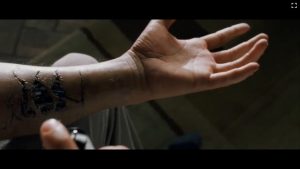Sequencing
Sequence 1: The movie opens to a digital-water fusion that, by the way of written text, tells the 3 Laws that robots follow.
Sequence 2: In a typical apartment, a black man gets ready to leave for the morning.
Sequence 3: Title text reads ‘Chicago 2035.’ We learn that the man is Detective Del Spooner, of Chicago PD. We see robots among the humans and a billboard ad announcing the debut of a new generation of robots.
Sequence 4: Spooner eats with his grandmother, Gigi, and expresses disdain for robots.
Sequence 5: Spooner chases a robot that was performing a duty for another human. He is later verbally reprimanded at work.
Sequence 6: Spooner is called to investigate the suicide of Dr. Albert Lanning, the founder of U.S. Robots and Mechanical Men. He interviews a digital recording of Dr. Lanning, which has limited responses as well as Dr. Lawrence Robertson, co-founder of USR, and Dr. Susan Calvin, a robot psychologist.
Sequence 7: While interviewing Dr. Calvin and scoping out the building, a robot comes to life, violates the 3 Laws (by attacking Spooner) and escapes the USR facility.
Sequence 8: He captures the robot and brings it in for questioning. The robot does not admit to murdering the man, expresses human emotion, and identifies himself as ‘Sonny.’ Dr. Robertson reclaims Sonny as property shortly after.
Sequence 9: Spooner looks for evidence at Dr. Lanning’s house. The robot-controlled security changes the demolition time from the early morning to minutes after Spooner’s arrival. He escapes death but loses any evidence.
Sequence 10: Spooner confronts Dr. Robertson. Dr. Calvin prepares to decommission Sonny at Dr. Robertson’s command.
Sequence 11: Spooner is attacked by tainted N-5s and we see he is part-robot. The N5s disappear before the police arrive to help. Spooner is put on medical leave because his boss believes he’s mentally ill.
Sequence 12: Through flashback, the film reveals that Spooner hates robots because, after colliding with another car, a robot decided to save Spooner over a young girl in the other car.
Sequence 13: Spooner talks to Sonny for more clues and Dr. Calvin decommissions Sonny.
Sequence 14: Spooner visits a warehouse site of retired robots and learns that the N5s want to revolt. He is chased from the site by the tainted N5s.
Sequence 15: N5s initiate militant control in the city. In troop-style formation they enforce curfew, take over the human police force, and send the human population indoors.
Sequence 16: Detective Spooner and Dr. Calvin enter USR headquarters. It is revealed that Dr. Calvin did not kill Sonny. Together, they confront VIKI, who has corrupted the N5s, and inject her with nanites to end her control. Detective Spooner reconciles with Sonny.
Sequence 17: Movie ends with Sonny standing over a ‘sea’ of N5s.

Scene Selection
Digital representations of Blackness and Otherness are not only eschewed based on historical representations of Black people, but also by the ideologies of the creator, current events, and countless other miniscule factors. However, when Black people are centered in the film in traditionally positive roles—for instance as the protagonist or the underdog hero—some of the ability to control these narratives is transferred to those characters. In I, Robot, Will Smith plays a detective and, despite his anti-robot rhetoric, is a remarkably likeable protagonist. Smith’s position as an agentic contributor to I, Robot complicates questions of who controls digital representations of Blackness.
The selected scene is a close shot of Detective Del Spooner’s forearm. The surrounding sequence offers exposition that connects Spooner to Dr. Lanning, gives heightened context for his abhorrence of robots, and allows us to sit with the superhuman ability he displayed in the previous N5 battle scenes. The shot is slightly angled from above, almost as if the audience is viewing Spooner’s arm as Spooner. The lighting shifts from sunlight to shadow across his forearm. His palm and leftmost forearm are illuminated and his arm hair is visible. The shadowy area of the shot holds his lacerated forearm and wiring runs beneath his skin. It is difficult to see the exact appearance of the wiring because of the poor lighting. His arm rests on his knee and his pant-covered leg is visible but blurred in the background of this shot. Set in the foreground, Spooner’s finger presses down the nozzle of a spray can but it is off-center and blurred. His left thumb is cut off in the shot.
In this shot, the film’s larger argument about the controlling, alien nature of technology is further extended through Spooner’s body. The sunlight falls against the ‘human’ fleshy part of his skin, immediately referencing the natural aspect of his body. Likewise, his wired interior is cast in shadow, such that the exact character of Smith’s Otherness remains obscured. Further, this scene is sequenced among scenes of Dr. Calvin preparing to decommission Sonny. The alienness of Spooner’s body is only underlined by the strangeness of Sonny presenting as robot yet human. However, the intimate angle of the shot serves to draw the viewer in and to, in turn, humanize Spooner’s body despite his part-metal composition. Even with this ‘humanizing’ effect it is evident that Spooner’s alienness is at the focus; the blurring of his fingers and body indicate that while his humanity is valid, his alienness is more visible.
This tension between the validity of Spooner’s humanity and the visibility of his alienness speaks directly to the tensions that proliferate among digital representations of Blackness. Spooner is human but he is changed, irreparably (and forcibly) marked by his history. Similarly, representations of Blackness reflect that oscillation between the mark of history, the truth of now, and the invisible wires that keep us all afloat.
word count: 950
